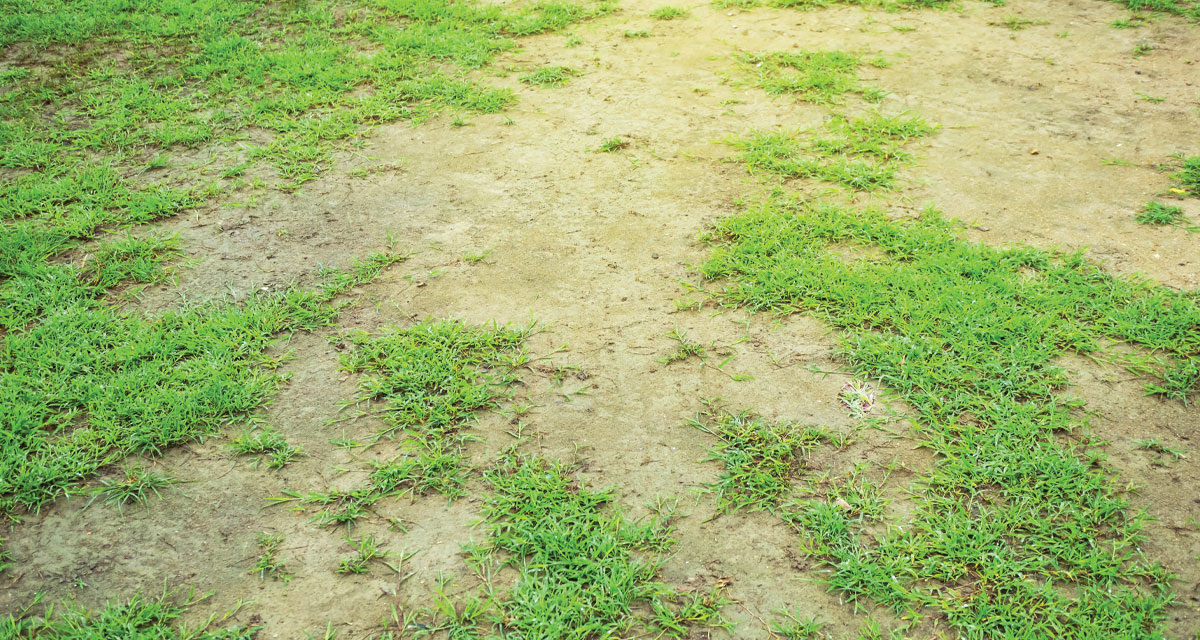The vividly green, lush landscape of grass has value to homeowners! It sends the message of care and order to any passerby. We don’t usually associate grass with thousands of oxygen-producing plants, but that’s precisely what they provide to humans. For all the positive benefits the unblemished lawn offers, it’s disheartening to have to ignore areas that cannot grow the desired result; therefore, a solution is needed!
Soil Type
The best method to determine a soil’s composition is through simple testing with minimal time or disruption. First, dig three to four inches below the surface with a trowel and place the contents into a bowl. Then, break the pieces apart and remove rocks and sticks until smooth. Next, grab a handful and squeeze it into a ball. Poke a hole into the center with your finger.
Now, determine your results:
- If the ball remains cohesive, it’s comprised mostly of clay.
- If it remains mostly intact, it’s loam—a good balance!
- A complete crumbling is sand.
Understanding the composition will help you correct the problem. Most likely, you’ll need to till the area and add at least two inches of enriched soil. On top of the compost, add a few inches of mulch to break down, further offering nutrients over time.
Sunlight
Most plants require a minimum of six hours of sunlight within an environment of rich soil. When only three or four hours are available, we often think only a few perennials exist in the category; however, partial sun plants usually yield strong flower power and striking blooms, while surviving in challenging conditions. Here are a few suggestions that do not disappoint!
- Anemone: As a member of the buttercup family, the anemone grows from fibrous roots. Usually planted in the fall to reveal an array of colorful flowers by spring.
- Anise Hyssop: As a medicinal herb, it’s also a tall, striking plant with lavender blooms appearing from mid-summer to early fall!
- Astilbe: High above a dark, green fernlike foliage, fall, feathery plumes appear in lavender, pink, red, or white flowers.
- Black–eyed Susan: Brighten up an area with bright yellow petals. While attracting pollinators, the blooms extend from summer through late fall.
- The Bleeding Heart: Growing to a height of 15 inches and spanning 12-inches, the beauty of this plant is its heart-shaped blooms cascading from arching stems. The plant is both easy to grow and tolerates challenging soil types.
- Columbine: A distinct bell-shaped flower often is purple in the spring and changes to maroon in the autumn. It also attracts hummingbirds.
Tip: If the soil receives large pools of water, aerate. By creating holes into the ground, you’ll encourage air and water flow.
Ground Cover
Without the time to amend the soil, one solution is to transition a barren area into a focal point with various stones and a sea of low-growing plants. Buy several varieties to weave layers and textures of color. Make sure to read the label. Most ground covers demand full sun to thrive.
- Creeping Phlox: An ideal plant for retaining or stone walls and hillsides.
- Creeping Thyme: Growing to a height of three inches, the plant adds beauty and color between garden stepping-stones, crowds out weeds, and spreads.
- Rupturewort: Also known as the “green carpet,” the dense evergreen foliage offers a splash of color in spring and fall. Like many ground covers, Rupturewort is reasonably soft when underfoot. Its popularity stems from a slight vanilla fragrance.
- Scotch Moss: Forms a soft mat that works well along walkways to minimize weeds. The beauty arrives when tiny translucent white flowers appear in spring.
Turf Options
Even shade-tolerant grasses need at least four hours of direct sunlight per day. If possible, try trimming limbs or removing trees to promote pockets of light. If grass seems like an impossibility, consider:
- Investing in a densely shaded grass seed, designed to thrive in low-light environments.
- Buying Zoysia grass plugs, which ensures a dense wear-resistant turf. The plant grows from the stolon, or runners, and expands from the main plant. Its deep and vigorous root system requires little water, and chokes out weeds!
Do not give up! You’ll have a beautiful lawn or attractive feature in no time! Good luck!
*Lisa is an N.C. State Extension Master Gardener and State Certified Beekeeper



















